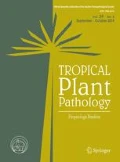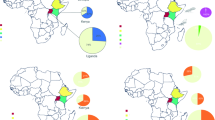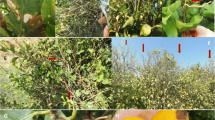Abstract
Surveys were conducted in some citrus-growing parts of Manipur, Northeast India for recording the incidence of “Huanglongbing” (HLB) symptoms. The purpose of this study was to confirm the presence of HLB in citrus orchards in different geographical locations of Manipur and to correlate the disease incidence with variation in elevation of the region. The presence of “Candidatus Liberibacter asiaticus” was detected in ten regions in Manipur using PCR with species-specific primers for “Ca. Liberibacter asiaticus.” A total of 128 (19.6%) of 653 samples were positive for “Ca. Liberibacter asiaticus.” The incidence was found to be highest (30.0 to 45.7%) in the lower elevation (700–1200 m above sea level) and was found to be least (5.0 to 10.0%) in higher elevation (1200–1500 m above sea level). HLB was detected in citrus species, viz., Citrus maxima, Citrus jambhiri, Citrus macroptera, Citrus medica, and Citrus reticulata. Sequencing of the 16S rRNA amplicon fragment and their phylogenetic analysis showed that these sequences clustered together with other “Ca. Liberibacter asiaticus” sequences from the rest of the world. Our results revealed the widespread occurrence of HLB in all economically important citrus species of Manipur as well as significant variation in the incidence of HLB across different elevations. The present scenario in Manipur calls for effective disease management strategies. Extension programs should be conducted to create awareness of HLB among the citrus growers to reduce the spread of HLB and preserve the citrus cultivation in this Indo-Burma biodiversity hotspot region.




Similar content being viewed by others
References
Altschul SF, Thomas LM, Alejandro AS, Zhang J, Zhang Z, Miller W, Lipman DJ (1997) Gapped BLAST and PSI-BLAST: a new generation of protein database search programs. Nucleic Acids Research 25:3389–3402
Aubert B (1987) Trioza erytreae Del Guercio and Diaphorina citri Kuwayama (Homoptera: Psylloidea), the two vectors of citrus greening disease: biological aspects and possible control strategies. Fruits 42:149–162
Bove JM (2006) Huanglongbing: a destructive, newly-emerging, century-old disease of citrus. Journal of Plant Pathology 88:7–37
Bove JM (2014a) Huanglongbing or yellow shoot, a disease of Gondwanan origin: will it destroy citrus worldwide? Phytoparasitica 42:579–583
Bove JM (2014b) Heat-tolerant Asian HLB meets heat-sensitive African HLB in the Arabian Peninsula! Why? Journal of Citrus Pathology, Retrieved from https://escholarship.org/uc/item/1665n4x9
Bove JM, Dwiastuti M, Triviratno A, Supriyanto A, Nasli E, Becu P, Garnier M (2000) UC Riverside International Organization of Citrus Virologists Conference Proceedings (1957-2010), in Incidence of Huanglongbing and Citrus Rehabilitation in North Bali, Indonesia 200–206
Capoor S, Rao D, Viswanath S (1967) Diaphorina citri Kuway., a vector of the greening disease of citrus in India. Indian Journal of Agricultural Science 37:572–579
Catling HD, Green GC (1972) The influence of weather on the survival and population fluctuations of Trioza erytreae (Del Guercio) — a vector of greening. International Organization of Citrus Virologists Conference Proceedings (1957-2010) 5(5). Retrieved from https://escholarship.org/uc/item/4w3015zq
Das AK, Rao CN, Singh S (2007) Presence of citrus greening (Huanglongbing) disease and its psyllid vector in the north-eastern region of India confirmed by the PCR technique. Current Science 92:12
Das AK, Nerkar S, Bawage S, Kumar A (2014) Current distribution of Huanglongbing (citrus greening disease) in India as diagnosed by real-time PCR. Journal of Phytopathology 162:402–406
Gasparoto MCG, Coletta-Filho HD, Bassanezi RB, Lopes SA, Lourenço SA, Amorim L (2012) Influence of temperature on infection and establishment of ‘Candidatus Liberibacter americanus’ and ‘Candidatus Liberibacter asiaticus’ in citrus plants. Plant Pathology 61:658–664
Gopal K, Gopi V, Kalyani L, Sreelatha M, Sreenivasulu B (2010) Symptom-based diagnosis of Huanglongbing (citrus greening) disease by PCR in sweet orange (Citrus sinensis osbeck) and acid lime (Citrus aurantifolia swingle). Archives of Phytopathology and Plant Protection 43:863–870
Gottwald TR (2010) Current epidemiological understanding of citrus Huanglongbing. Annual Review of Phytopathology 48:119–139
Halbert SE, Manjunath KL (2004) Asian citrus psyllids (Sternorrhyncha: psyllidae) and greening disease of citrus: a literature review and assessment of risk in Florida. Florida Entomology 87:330–353
Hall T (1999) BioEdit: a user- friendly biological sequence alignment editor and analysis program for Windows 95/98/NT, in Nucliec acids symposium series no 41:95–98
Hammer Ø, Harper DA, Ryan PD (2001) PAST: paleontological statistics software package for education and data analysis. Palaeontologia Electronica 4:9
Jagoueix S, Bove JM, Garnier M (1994) The phloem-limited bacterium of greening disease of citrus is a member of the subdivision of the Proteobacteria. International Journal of Systematic Bacteriology 44:379–386
Jagoueix S, Bové JM, Garnier M (1996) PCR detection of the two Candidatus Liberobacter species associated with greening disease of citrus. Molecular and Cellular Probes 10:43–50
Janda JM, Abbott SL (2007) 16S rRNA gene sequencing for bacterial identification in the diagnostic laboratory: pluses, perils, and pitfalls. Journal of Clinical Microbiology 45:2761–2764
Jenkins DA, Hall DG, Goenaga R, Jenkins DA, Hall DG, Goenaga R (2015) Diaphorina citri (Hemiptera: Liviidae) abundance in Puerto Rico declines with elevation. Horticultural Entomology 108:252–258
Kaipeng DL, Karmakar K, Ghosh S, Rahaman L, Nath N, Sharma BK (2017) Huanglongbing: causal disease for the decline of Citrus reticulata and Citrus macroptera production in Tripura, Northeast India. Journal of Plant Pathology 99:273–278
Kumar S, Stecher G, Li M, Knyaz C, Tamura K (2018) MEGA X: molecular evolutionary genetics analysis across computing platforms. Molecular Biology and Evolution 3:51547–51549
Li W, Levy L, Hartung JS (2009) Quantitative distribution of “Candidatus Liberibacter asiaticus” in citrus plants with citrus Huanglongbing. Phytopathology 99:139–144
Lin KH (1956) Observations on yellow shoot of Citrus. Acta Phytopathologica Sinica 2:1–11
Lopes SA, Frare GF, Bertolini E, Cambra M, Fernandes NG, Ayres AJ, Marin DR, Bové JM (2009) Liberibacter associated with citrus Huanglongbing in Brazil: ‘Candidatus Liberibacter asiaticus’ is heat tolerant, ‘Ca. L. americanus’ is heat sensitive. Plant Disease 93:257–262
Magomere T, Obukosia SD, Mutitu E, Ngichabe C, Olubayo F, Shibairo S (2009) PCR detection and distribution of Huanglongbing disease and psyllid vectors on citrus varieties with changes in elevation in Kenya. Journal of Biological Sciences 9:697–709
Murray RGE, Schleifer KH (1994) Taxonomic notes: a proposal for recording the properties of putative taxa of prokaryotes. International Journal of Systematic Bacteriology 44:174–176
Murray RGE, Stackebrandt E (1995) Taxonomic note: implementation of the provisional status Candidatus for incompletely described procaryotes. International Journal of Systematic Bacteriology 45:186–187
Nakashima K, Prommintara M, Ohtsu Y, Kano T, Imada J, Koizumi M (1996) Detection of 16S rDNA of Thai isolates of bacterium like organisms associated with the greening disease of Citrus. Jircas Journal 3:1–8
Nguyen LT, Schmidt HA, von Haeseler A, Minh BQ (2015) IQ-TREE: a fast and effective stochastic algorithm for estimating maximum-likelihood phylogenies. Molecular Biology and Evolution 32:268–274
Sanabam R, Somkuwar BG, Thingnam G, Moirangthem S, Handique PJ, Huidrom S (2012) CIBMAN: database exploring Citrus biodiversity of Manipur. Bio Information 8:838–840
Schwarz RE, Green GC (1972) Heat requirements for symptom expression and inactivation of the greening pathogen. Proceeding of the 5th conference, IOCV, Univ. Florida press, Gainesville 44–51
Sharma BD, Hore DK, Gupta SG (2004) Genetic resources of Citrus of North-Eastern India and their potential use. Genet. Resour. Crop Evolution 51:411–418
Shimwela MM, Hossein NK, Halbert SE, Manjunath K, Minsavage G, Timilsina S, Massawe DP, Jones JB, Bruggen AHC (2016) First occurrence of Diaphorina citri in East Africa, characterization of the Ca. Liberibacter species causing Huanglongbing (HLB) in Tanzania, and potential further spread of D. citri and HLB in Africa and Europe. European Journal of Plant Pathology 146:349–368
Teixeira DC, Saillard C, Eveillard S, Danet JL, da Costa PI, Ayres AJ, Bové J (2005) Candidatus Liberibacter americanus’, associated with citrus Huanglongbing (greening disease) in São Paulo state, Brazil. International Journal of Systematic and Evolutionery Microbiology 55:1857–1862
Teixeira DC, Saillard C, Couture C, Martins E, Wulff NA, Jagoueix SE, Yamamoto PT, Ayres AJ, Bove JM (2008) Distribution and quantification of Candidatus Liberibacter americanus, agent of Huanglongbing disease of citrus in Sao Paulo State, Brasil, in leaves of an affected sweet orange tree as determined by PCR. Molecular and Cellular Probes 22:139–150
Wang N, Pierson EA, Setubal JC, Xu J, Levy JG, Zhang Y, Li J, Rangel LT, Martins J (2017) The Candidatus Liberibacter–host Interface: insights into pathogenesis mechanisms and disease control. Annual Review of Phytopathology 55:451–482
Zheng Z, Chen J, Deng X (2018) Historical perspectives, management, and current research of citrus HLB in Guangdong Province of China, where the disease has been endemic for over a hundred years. Phytopathology 108:1224–1236
Acknowledgments
We thank the local citrus growers of Manipur for providing the plant samples. We are also thankful to the Director, Institute of Bioresources and Sustainable Development (IBSD), Imphal, for providing financial assistance and research facilities. The IBSD communication number of the manuscript is IBSD/2020/01/023.
Author information
Authors and Affiliations
Contributions
HSD and EJD conceptualized the overall research work. EJD carried out the sample survey, data collection, and laboratory analysis. Bioinformatics and statistical analysis were performed by RKL. The manuscript was drafted by EJD and HSD. RM and NSS carried out proofreading and helped in correcting the manuscript. All authors read and approved the final manuscript.
Corresponding author
Ethics declarations
Conflict of interest
The authors declare that they have no conflict of interests.
Additional information
Publisher’s note
Springer Nature remains neutral with regard to jurisdictional claims in published maps and institutional affiliations.
Rights and permissions
About this article
Cite this article
Devi, E.J., Labala, R.K., Modak, R. et al. Molecular detection of “Candidatus Liberibacter asiaticus” causing HLB in Manipur and correlation of its incidence with elevation. Trop. plant pathol. 45, 658–667 (2020). https://doi.org/10.1007/s40858-020-00392-3
Received:
Accepted:
Published:
Issue Date:
DOI: https://doi.org/10.1007/s40858-020-00392-3




